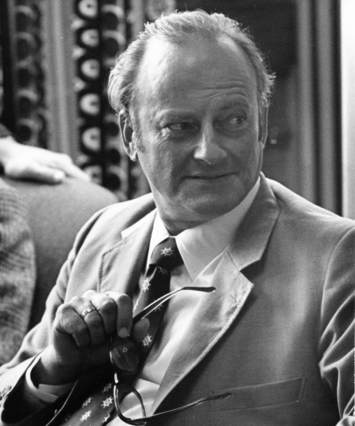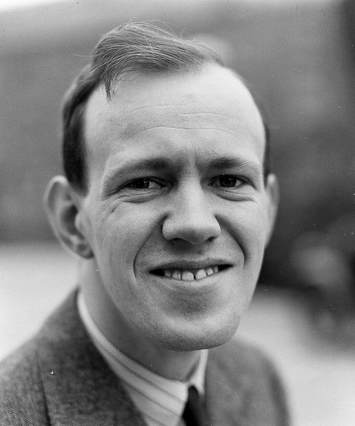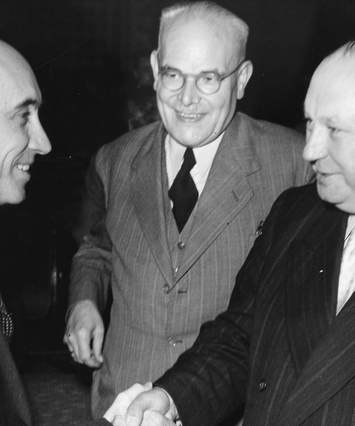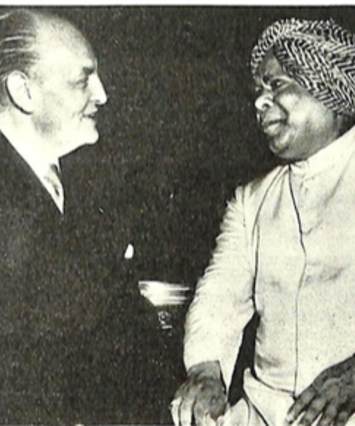National Minorities in Europe: 70 Years of the Bonn – Copenhagen Declarations
What is this anniversary about? Talking with a group of Students from Tbilisi, Georgia at the recent World Forum for Democracy one of them surprised me because he knew right away of what I was talking about: On 29 March 1955 the Governments of the Federal Republic of Germany and Denmarkissued declarations, recognizing the ethnic/linguistic minorities on their territories, the Danish minority in Germany and the German minority in Denmark. These Declarations provided constructive institutional frameworks, thus leaving behind more than a century of wars. It was an early enactment of Minority Rights in Europe, if not the first.
Already 1,000 years ago that area stretching between Hamburg and Aarhus was coveted: the Schlei Estuary and the nearby Treene River almost creating a navigable shortcut between the Baltic and the North Seas. On the shore of the Schlei was a large Viking trading centre. Altogether it must have been the equivalent of today’s Panama or Suez Canals.
So, a fast forward to 1920, when following the Versailles Treaty the provinces on either side of the border voted about which State they wished to adhere to. But this did not settle the fate of the minorities who by and large continued to be second class citizens in education, in civic, professional and religious liberties. Then in 1938 Nazi Germany concluded a Peace Treaty with the Kingdom of Denmark, after which it occupied it in 1940-45.
The post-WWII partition into Allied Occupation Zones brought North Germany into the British Zone. In 1997 the German Federal Agency for Civic Education studied the question of an intentional British Occupation Policy during 1945-49 and retains a key statement about aiming “to rebuild a community”. We also learn that among the many pressing needs this Authority addressed the Danish-German minority issues by a) encouraging Denmark on one hand and b) on the other, hosting meetings with the protagonists in their own Zone, and c) initiating the Wilton Park meetings in the UK.
The Meetings at Caux, Switzerland
From the records of the Caux-IofC Conference Centre in Switzerland we can see that in the years 1946-50 a total of 888 visitors from Denmark and 3,113 from Germany came there. Among them were people specifically from the region of Schleswig-Holstein, giving care to rebuilding the German-Danish relations. In those days at Caux, one of the frequently proposed recipes for moral and spiritual renewal was: “Sound homes, team-work in Industry, a united nation.” And another one was: “Remember, not who is right, but what is right!” This also led to personal initiatives, such as three Danish lady teachers crossing the border southwards to go to work in Flensburg.
Recently, Edward Peters reported from a meeting he attended in southern Denmark: “We heard from a Dane of German origin, Urte Hvidt, now in her late 80s. During World War Two, at the age of seven, she and her siblings were taken by their mother to Flensburg in Schleswig to escape the war in Hamburg, while their father was working as a doctor at the battlefront. Going to the German school, she experienced hostility from the children at the Danish school. After the war, the family was reunited. By then her mother had become an independent woman and the old roles in the family did not work. Divorce was close but through a meeting with IofC 's forerunner Moral Re-Armament (MRA), her parents were helped to find their way back to each other. They bought a large house with 17 rooms on the Danish side of the German border to create a meeting place - "a place of reconciliation" - where different people could come and live. They must have had a small but real part, I thought, in changing the atmosphere in Schleswig towards what it is today.”
Among the Caux participants from Germany and Denmark were some who particularly devoted time to the pending minority issues on either side of the borders. Outcomes from this working group were fed into the respective parliamentary channels.
The decisive months
Onwards to the year of 1955: The working groups had by then drafted the principles and the concrete domestic measures that would remove the obstacles to progress. The description of some decisive days in the first three months (now 70 years ago) give us a glimpse into how the Declarations came to be launched. Garth Lean writes about these events in his book: “Good God, it works!” Here follows a synopsis:
20 January: In Copenhagen a group meets in a private home with Ole Björn Kraft, outgoing Foreign Minister and leader of the Opposition. Kraft had been to Caux and had found a lot encouragement from Frank Buchman’s work. The group takes time to reflect in quiet with Kraft, looking for inspiration. The idea emerges that he might meet informally with Heinrich Hellwege, member of the German cabinet, who also had been to Caux, but the two did not yet know each other.
21 January: Hellwege agrees to this proposal and suggests meeting in Hamburg. Kraft consults Prime Minister H.C. Hansen who approves the informal approach, as he had earlier signaled the need for cooperation with Germany - during a NATO Meeting.
30 January: Kraft and Hellwege meet in Hamburg, Kraft is accompanied by Garth Lean and Hellwege by Sydney Cook, both of them part of Frank Buchman’s MRA team. Kraft advises against a formal Treaty but instead for simultaneous, independent Declarations on both sides. (Ed.: The likely refusal of a formal Treaty has to be seen on the background of Nazi Germany’s Peace Treaty with Denmark in 1938, which it occupied two years later.) Hellwege is new to the problem, but very aware of German post-war responsibilities, therefore concluding: “We must take the initiative.” Hellwege returns straight to the Chancellor in Bonn, asking him to act.
3 February: The Copenhagen Daily Berlingske Tidende reports that the Government had received an invitation by Bonn to negotiate.
28 February – 5 March: The formal, concluding negotiations take place in Copenhagen.
29 March: Prime Minister Hansen goes to Bonn. He and Chancellor Adenauer each sign their respective Declarations. In due course they are ratified by the respective Parliaments.
Valid points
Later, the “Den danske Udenrigstjenesté” (Danish Foreign Affairs Review) evaluated these Declarations as “…perhaps the most significant event in Danish foreign policy in the fifties.”
Less than ten years ago, as IofC representative to the Council of Europe, I was working with the Ambassador from Denmark on a very different theme. As that task neared conclusion we freely discussed other matters and I referred to the Declarations. He unexpectedly switched from our usual working English language to German and reiterated to me just about the same words as quoted in the Foreign Affairs Review above.
It is well worth retaining what the Key Provisions of the Bonn - Copenhagen Declarations have in common:
- Personal declaration of adherence to a minority may neither be checked nor challenged by the authorities.
- Members of a minority and their Organisations may not be obstructed in their written and spoken expressions.
- Disbursement of public funds to them may not be handled differently from other citizens.
- The special interest of minorities to the religious, cultural and professional relations to the neighbour State is being recognized.
Then follow each State’s specific domestic provisions to enact and/or remedy matters concerning political representation, education, freedom of assembly and belief.
In hindsight
On Easter Monday of 2005 the Evangelical Church of Germany celebrated the 50th anniversary of the Declarations with the announcement: “German and Danish Christians don’t need a border.” Then detailing that the State borders were set by the 1920 vote, but the Churches have no borders until this day. The Schleswig Diocese includes six Parishes in Denmark and the Danish Church includes 24 Parishes in Germany. This unique arrangement was based on the Declarations of 1955.
It is very likely that Dean Paul Brodersen of Copenhagen from the Danish side and Prof. Heinrich Rendtorff, a Lutheran leader in Schleswig-Holstein, both friends of Frank Buchman, have each contributed to the respective Churches’ attitudes of “don’t need a border”.
Ten years ago, a headline of the daily Hamburger Abendblatt, raised in an amusing tone: “Was there ever something with Denmark?” It conveys that 60 years after the Declarations the public perception was indeed freed from any prejudices.
Nine years ago, the Danish History Professor and Consul-General Henrik Becker-Christensen wrote an assessment for the Konrad Adenauer Foundation. It covers the history and the 1955 Declarations. Then it rolls out the adjustments and improvements of the institutional frameworks of the respective minorities through the decades until recently. Becker-Christensen then raises the question if this process was a model, an export article, so to speak? He rightly states that no two conflicts are identical, hence an automatic transfer cannot be envisaged. But relevant experiences and instruments were there for the pick.
Becker-Christensen also refers to the European Framework Convention for the Protection of National Minorities of 1995. One of this Convention’s designers was Senator Karl Mitterdorfer, who as a young man got trapped by the bitter ‘choice’ of being drafted either into Mussolini’s or into Hitler’s War Machines, which, at the end of World War II left him as a Stateless Person. Decades later, sometime after the launch of the Convention he would share about his and his colleagues’ motivation as “…taking away the divisiveness from the borders”.
On 17 January of this year the regional paper Der Nordschleswiger carried an article about an evening lecture on the 70 years of Bonn-Copenhagen, pointing out that: “The Society for Schleswig-Holstein History has been invited by the Historik Samfund for Sønderjylland to commemorate the 70th anniversary of the Bonn-Copenhagen Declarations.” Further down in the article the Chairman of the Society is being quoted: “We were incredibly happy about the invitation (to commemorate together with the Historik Samfund)”. This brief glimpse into a current local event shows the sheer pleasure that comes from working without obstacles.
As we light the anniversary candles for the Bonn – Copenhagen Declarations, it is worth noting that there were many persons on many levels and places who have contributed to this development, some have found a brief mention in the lines above. But all of them would surely echo the sentence that is the header of a new website launched last year: “We are one humanity”. This is most likely also the dream of the students from Georgia who talked to me at the recent World Forum for Democracy.
Christoph Spreng
Source material not mentioned above:
Jörgensen, Kjeld: Initiatives of Change Denmark 1938 – 55, Caux Edition 2000
Lean, Garth: Frank Buchman – a life, www.frankbuchman.info Constable 1985
Thaler, Peter: Of Mind and Matter, the duality of… Purdue Univ. Press 2009
Vock, Franz Johann: Zur Bedeutung der Moral für die Politik. Untersuchung der
Arbeit der Moralischen Aufrüstung an drei Fallbeispielen. Dissertation zur
Erlangung des Doktorgrades an der geisteswissenschaftlichen Fakultät der
Universität Salzburg, 365 pages unpublished manuscript 1989
Christoph Spreng is IofC-International’s representative to the Council of Europe. He was part time correspondent for Swiss newspapers on international affairs in Geneva. He was also INGO Project Manager, Elaboration of the Council of Europe White Paper on Intercultural Dialogue 2006-2008, and contributor of a chapter in “Human Rights in culturally diverse societies – Challenges and perspectives”, Council of Europe, 2009. Spreng also served as an INGO Expert for the European Union/CoE Joint Programme “Minorities in Russia: developing languages, culture, media and civil society” 2009-2011.
English






